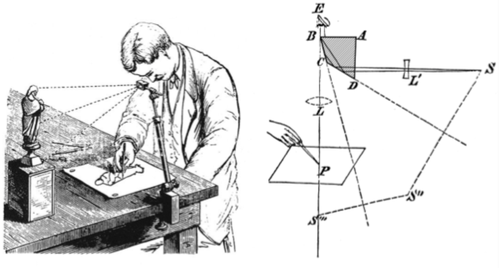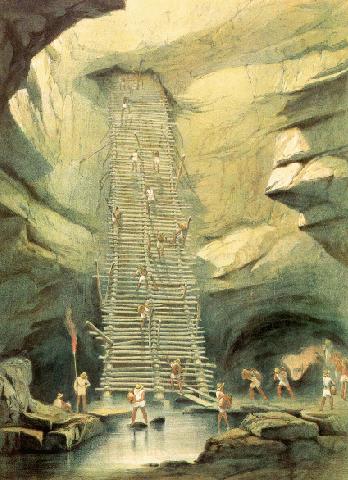
Camera Lucida in use. Optics of Wollaston Camera Lucida.
Adrian Hill on Malcolm Mc Neill and William S. Burroughs’s Ah Pook Is Here
The following is a three part exploration of Malcolm Mc Neill and William S. Burroughs’ word-image collaboration during the 1970s. This is part three. See part one here, and part two here.
Conversations with a Dead Man
AND YOU ASK ME why I do not believe in psychic events?
How can I not believe? you may ask given what I have seen, what I have learned.
And it occurs to me that I cannot provide for an adequate answer, because I do not believe the proper words exist for me to explain my agnosticism. You cannot know, therefore, and neither it seems can I.
—Charles Pellegrino, Titanic
In 1839-40, the American explorer John Stephens planned a trip traveling through Honduras and Guatemala, then north to the ancient ruins of Palenque. At the time, the Palenque ruins were the only remnants of ancient Mayan civilization known to exist. Stephens also returned to Central America to explore the Yucatan region in 1843. An artist named Frederick Catherwood (1799-1854) accompanied Stephens on both trips and provided the visual documentation of their travels.
When Malcolm Mc Neill first began researching the ancient Maya for image references, retrieving information was often a long, drawn-out process requiring trips to libraries or museums. He had stumbled upon drawings by Catherwood, but had no information about the artist. Nonetheless these drawings became inspiration for the realistic style used in the artwork for Ah Pook is Here. Catherwood used the camera lucida to accurately depict the ruins he drew, a technique that uses an optical lens to project a version of the image being drawn onto the artist’s paper in order to be traced.
Two books, Incidents of Travel in Central America, Chiapas and Yucatán (1841) and Incidents of Travel in Yucatán (1843), in addition to one watercolour folio, Views of Ancient Monuments in Central America, Chiapas and Yucatan, (1844) were published on the basis of the adventurers’ travels.
 “Cenote Xtacumbilxunan, at Bolonchen, Yucatan” by Frederick Catherwood. First published in Views of Ancient Monuments in Central America, Chiapas and Yucatan.
“Cenote Xtacumbilxunan, at Bolonchen, Yucatan” by Frederick Catherwood. First published in Views of Ancient Monuments in Central America, Chiapas and Yucatan.
It would be years later before Mc Neill would learn more about Catherwood. In 2003, Mc Neill decided spontaneously to look up information on Catherwood while conducting research at the Los Angeles County library. In 2003, Mc Neill discovered a biography of the artist called The Lost Cities of the Mayas: the Life, Art and Discoveries of Frederick Catherwood by Fabio Bourbon, which laid out a series of uncanny coincidences between Catherwood’s life and Mc Neill’s own:
…Frederick Catherwood was an English illustrator, and also of Scottish descent.
He...
You have reached your article limit
Sign up for a digital subscription and continue reading all new issues, plus our entire archives, for just $1.50/month.
Already a subscriber? Sign in




